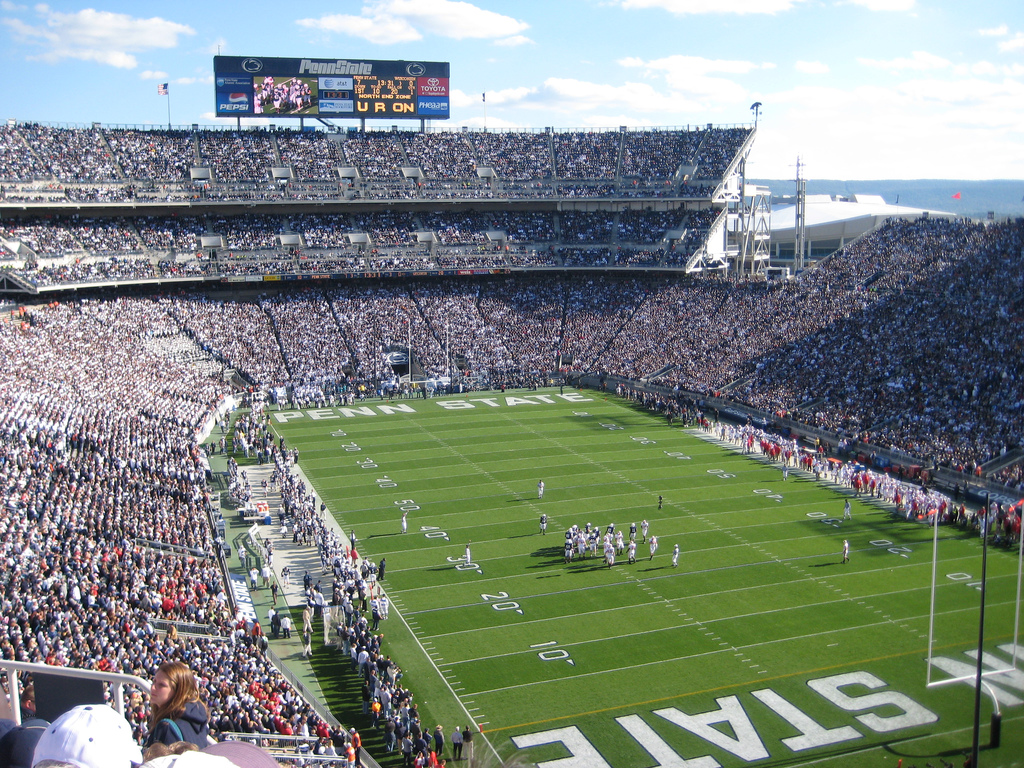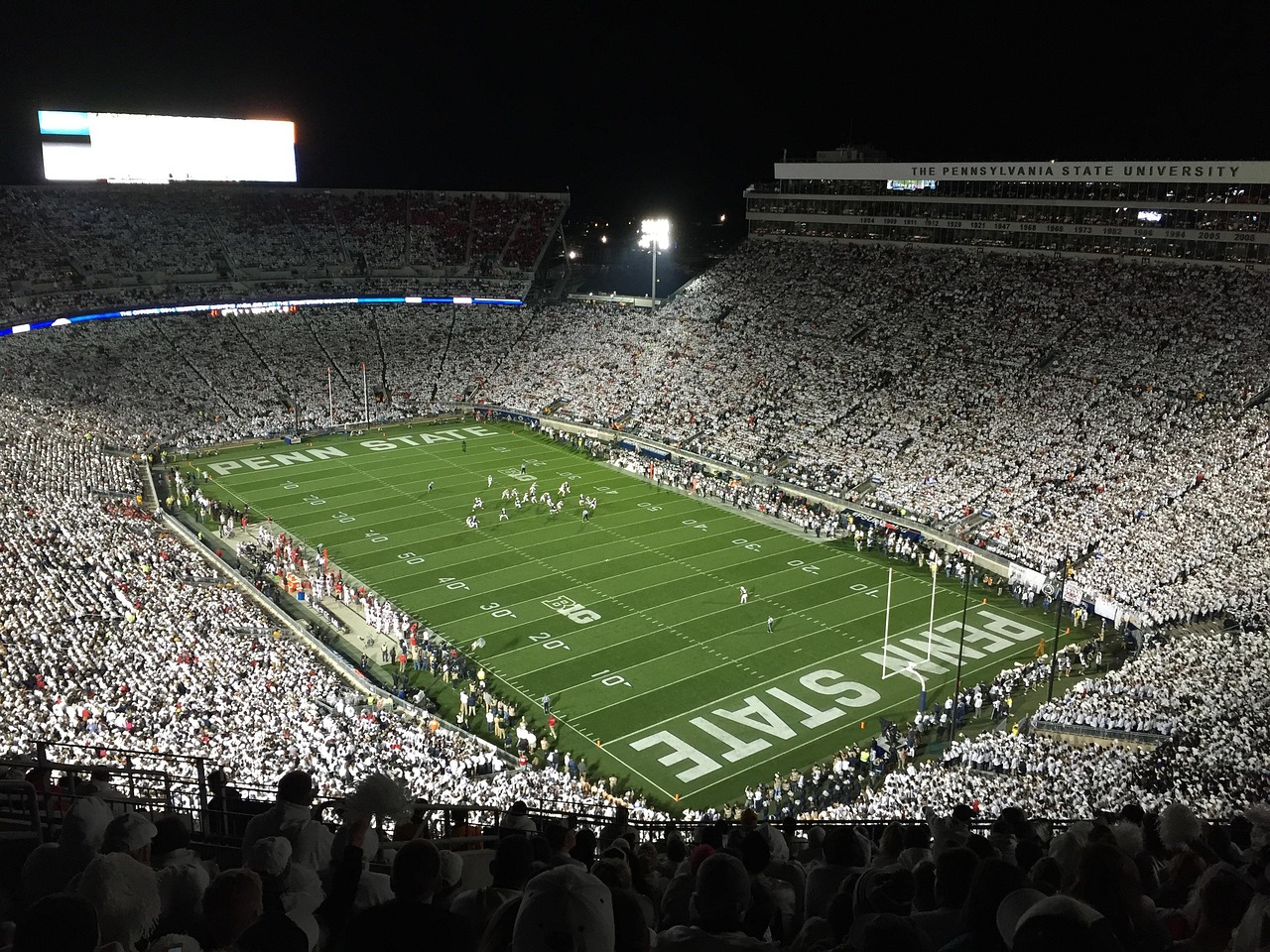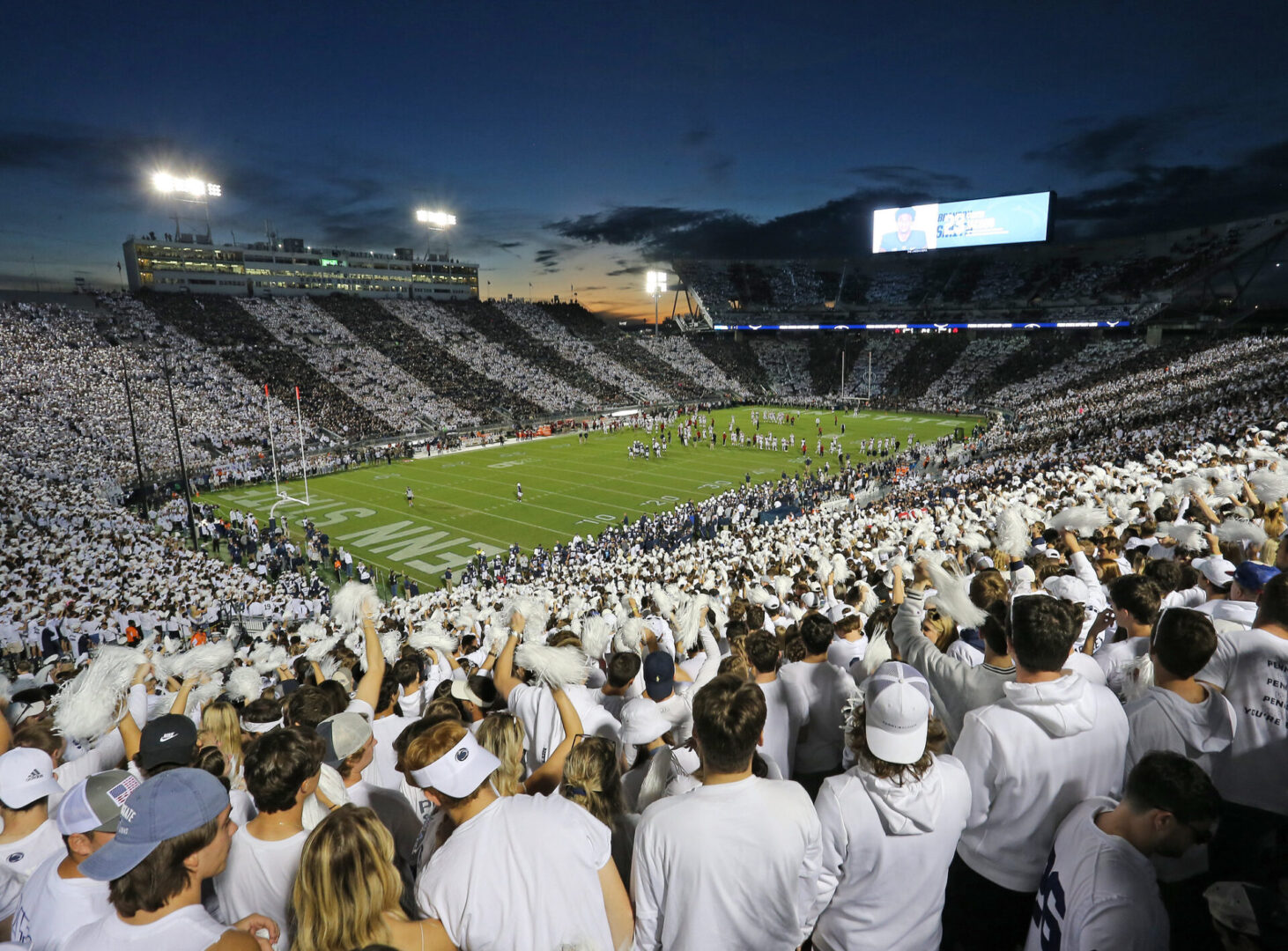When you think about the true heart of college football, especially in Pennsylvania, one place really stands out. This spot, a cherished gathering place for many, is where the Penn State Nittany Lions football squad takes the field. It's a place where the energy feels almost alive, where traditions run deep, and where countless memories are made with every single game. This stadium, a significant landmark for the university, has been the backdrop for some truly memorable moments in sports history for decades now.
For a long, long time, this particular football arena has served as the main home for the Penn State Nittany Lions. It's a structure that commands attention, standing as a very large venue in the entire Western Hemisphere, and it's also counted among the largest sports arenas anywhere on the globe. Just thinking about the sheer number of people it can hold gives you a sense of its incredible scale, making it a place where many, many voices can join together in support of their team.
This remarkable place, you know, has a pretty interesting story to tell, going back quite a ways to its beginnings. Over the years, it has seen a good deal of change, with various improvements and expansions shaping it into the icon it is today. There's a lot to discover about how this stadium came to be, what makes game days there so special, and what's on the horizon for its future, as it continues to be a central part of the Penn State experience.
Table of Contents
- A Long History for the Penn State Football Stadium
- What Makes the Penn State Football Stadium So Special?
- The Grand Scale of Penn State Football Stadium
- How Has the Penn State Football Stadium Evolved Over Time?
- The Electric Atmosphere at Penn State Football Stadium Games
- What's Happening with the Penn State Football Stadium Right Now?
- The Future Vision for Penn State Football Stadium
- Who is Honored by the Penn State Football Stadium's Name?
A Long History for the Penn State Football Stadium
So, the place we now know as Beaver Stadium, the actual home of the Penn State Nittany Lions football team, has been in its current spot since 1960. That's a good many years of cheering and football action happening right there. Before it settled into its present location, this significant college football stadium, you know, had a bit of a journey. It was, in fact, built in 1909, which makes it one of the older, truly important football stadiums across the whole country. Its journey to becoming the famous Penn State football stadium we recognize today involved some real changes over time, shaping its identity and its role for the university community.
Actually, the stadium's story is a bit more involved than just its 1960 move. It had a couple of earlier versions, or what you might call precursors, situated in entirely different parts of the University Park campus. These earlier spots, known as Old Beaver Field and New Beaver Field, served as the team's home before the current structure came into being. This history, you know, shows a continuous dedication to providing a strong home for the football team, with each iteration building upon the last to create what we see now. The name itself, for all three versions of the Penn State football stadium, pays tribute to the very same important individual, linking them all through a shared legacy.
What Makes the Penn State Football Stadium So Special?
When you consider what truly sets the Penn State football stadium apart, it's more than just its physical attributes. There's a certain feeling, a unique spirit that comes alive on game days, that is simply unmatched. The environment created at a Penn State football game is, in many people's opinions, second to none. It's a collective energy that envelops everyone present, from the dedicated fans in the stands to the guests experiencing it for the first time. This atmosphere, you know, is a significant part of what draws people in and keeps them coming back, year after year.
- The Waldorf Hilton London London
- Maryland Institute College Of Art
- Crowne Plaza Chicago West Loop An Ihg Hotel
- Johnson Hardware
- Banner Health Clinic
The recent improvements to West Shore Home Field at this Penn State football stadium are, you might say, designed to make that already incredible experience even better for everyone involved. These enhancements are all about elevating the time spent by fans and visitors, ensuring that every moment at the game feels even more special and engaging. It's a clear sign that the people behind the stadium are truly committed to making sure the game day experience remains at the very top of what college football has to offer, which is pretty neat.
The Grand Scale of Penn State Football Stadium
Speaking of its size, the Penn State football stadium is, truly, a structure of immense proportions. It holds the distinction of being the second largest stadium across the entire Western Hemisphere, which is a pretty significant achievement. Beyond that, when you look at all the stadiums around the globe, it ranks as the fourth largest in the world. With a seating capacity that can welcome 106,572 people, it's a place where a truly vast crowd can gather, all sharing in the excitement of the game. This immense scale, you know, contributes to that unique atmosphere, making every cheer and roar feel incredibly powerful.
Just try to picture that many people, all in one place, focused on the same event. It's a sight that's almost overwhelming in its scope. This very large capacity means that the stadium isn't just a place for a game; it's a massive gathering point, a place where many thousands of individuals can come together to support their team. The sheer volume of people, you know, creates a kind of collective energy that's hard to describe unless you've been there, making the Penn State football stadium a truly memorable venue for sports enthusiasts.
How Has the Penn State Football Stadium Evolved Over Time?
The Penn State football stadium, as we've touched upon, has a history marked by growth and change. Its current form, completed in 1960, came about when the earlier Beaver Field was taken apart and moved from its original spot, which was just northeast of Rec Hall, to where it stands today. This relocation was a big step in its development, setting the stage for the stadium's continued expansion and its becoming one of the nation's truly premier football venues. It's a story of constant adaptation, you know, to meet the growing needs of a popular team and its passionate followers.
There have been quite a few periods of expansion and updates over the years. For instance, before the 2001 season, there was a significant project that added more than 12,000 seats, really boosting the stadium's capacity. This kind of ongoing work shows a commitment to keeping the Penn State football stadium a top-tier facility, ensuring it can continue to host large crowds and provide a good experience. These expansions, you know, are part of what has allowed the stadium to maintain its status as a major player in the world of college sports arenas.
The Electric Atmosphere at Penn State Football Stadium Games
The feeling you get at a game at the Penn State football stadium is, honestly, something quite special. It's a place where the passion of the fans is incredibly visible. One of the most famous traditions involves students setting up camp, sometimes for days, just to secure a good spot for home games. This practice, you know, truly highlights the level of dedication and excitement that surrounds every match. It's a testament to how much these games mean to the student body and the wider community.
The energy inside the Penn State football stadium on game day is, you might say, palpable. From the moment you approach the grounds, there's a buzz in the air, a sense of anticipation that builds until kickoff. This collective excitement, fueled by thousands of voices, creates a truly unique and powerful atmosphere that is often talked about by those who visit. It's a place where the crowd truly becomes part of the game, influencing the mood and adding to the overall spectacle, which is pretty cool.
What's Happening with the Penn State Football Stadium Right Now?
As of late, there's been a good deal of activity concerning the Penn State football stadium, signaling a significant period of change. Following the 2024 football season, work began, with some initial steps like the felling of certain structures. Penn State officials have actually shared digital images showing what a renovated Beaver Stadium will look like, giving everyone a glimpse into its future appearance. These plans, you know, also include specific details about upcoming changes to seating arrangements and parking options, all set for the 2025 season.
The project is a really big undertaking. Penn State is planning to put in about 7,900 temporary seats at the Penn State football stadium during this renovation period. This is part of a larger, massive renovation effort that has a set timeline, with completion scheduled for 2027. It's a multi-year process that aims to update and improve many aspects of the venue, ensuring it remains a premier spot for college football for many years to come. This commitment to ongoing improvement is, you know, a pretty clear indication of the stadium's importance.
There's also news about the name of the field itself. Starting with the 2025 season, West Shore Home Field at Beaver Stadium will be the new name for the playing surface at the Penn State football stadium. Penn State has also offered some insights into the construction process, giving people a look at how the work is progressing. They've also provided more information about premium seating options that will be available, which is pretty interesting for those looking for a different game day experience.
For the 2024 season, there are already some noticeable updates at the Penn State football stadium. For instance, expansions to gates A, E, and F are among the highlights of the changes for this season. These immediate improvements are part of the broader plan, showing that the stadium is constantly being refined and improved, even as the larger renovation project moves forward. It's a place that's always, you know, looking to offer a better experience for its visitors.
The Future Vision for Penn State Football Stadium
The plans for the Penn State football stadium extend beyond just the current renovations, painting a picture of its future as a truly modern and inviting venue. The goal is to make it a destination that draws fans from all over, both near and far, further solidifying its place as a symbol of the university's enduring spirit. This vision, you know, is about more than just football; it's about creating a lasting legacy and a truly exceptional place for community and shared experiences.
The stadium, in its ongoing transformation, is really working to ensure it remains one of the nation's premier football venues. The focus is on providing a top-tier experience for everyone who walks through its gates, whether they are long-time fans or new visitors. This forward-looking approach, you know, aims to keep the Penn State football stadium at the forefront of college sports facilities, ready to welcome generations of supporters.
Who is Honored by the Penn State Football Stadium's Name?
It's interesting to consider how the Penn State football stadium got its name, as it connects back to a specific individual. The stadium, along with its earlier versions, Old and New Beaver Field, were all named in honor of the same influential man. This naming tradition, you know, links the stadium's long history to a person who clearly made a significant impact on the university or its athletic programs. It's a way of preserving a piece of the past within the very fabric of the stadium itself.
To understand the full story of the Penn State football stadium, it's worth looking into the origins of its name and the individual it commemorates. This detail adds another layer to the stadium's rich narrative, helping to explain why it holds such a special place in the hearts of many. It's a piece of history that, you know, continues to resonate with the stadium's identity today.
Related Resources:



Detail Author:
- Name : Kenyon Hahn
- Username : bernardo.rodriguez
- Email : tcrona@yahoo.com
- Birthdate : 2002-04-20
- Address : 689 Leland Alley Apt. 513 Runtebury, WY 63487-2321
- Phone : 1-216-509-1180
- Company : Heidenreich-Ritchie
- Job : Garment
- Bio : Quia est autem eos sequi vel cumque. Optio rem soluta nulla sit. Quod veniam voluptatem iure est. Voluptates architecto nostrum rerum molestias.
Socials
facebook:
- url : https://facebook.com/kody_dev
- username : kody_dev
- bio : Velit voluptatum dignissimos non possimus ut quia.
- followers : 3671
- following : 162
instagram:
- url : https://instagram.com/kody.wilkinson
- username : kody.wilkinson
- bio : Pariatur ut et iste veritatis adipisci nam quas. Eaque velit labore magnam praesentium.
- followers : 3158
- following : 1891
twitter:
- url : https://twitter.com/kody_wilkinson
- username : kody_wilkinson
- bio : Iste rerum eveniet dicta. Non in praesentium illum eaque repudiandae. Modi suscipit voluptas dolorem quisquam neque ut at accusamus.
- followers : 108
- following : 577
tiktok:
- url : https://tiktok.com/@kody1138
- username : kody1138
- bio : Rem ut pariatur sapiente sunt totam ut laudantium. Esse quas cumque libero aut.
- followers : 5983
- following : 2251